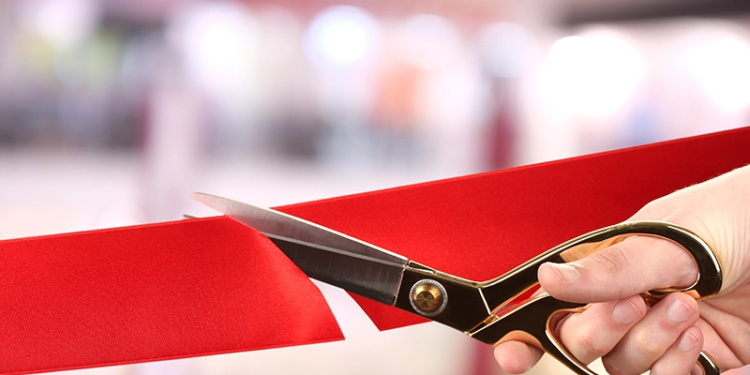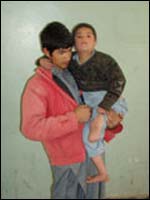
The plane was an old, rickety 727. Half the seatbelts didn’t work and overhead bins would open unexpectedly. As the plane circled, preparing to land, the passengers could see the
city on a large plateau, surrounded by a vista of some of the world’s highest mountains.
When the aircraft came closer, signs of war damage began to appear. Blown-up tanks and chunks of military equipment littered the roadsides. Battle-damaged planes and aircraft cannibalized for parts lined the sides of the runway. The terminal bore the unmistakable signs of recent conflict and repairs.
Later, as they traveled to their hotel, a group of passengers
saw bullet holes and other grim reminders of recent fighting
marring the buildings along the streets. On arrival, they found
that the top three levels of the five-story hotel were
uninhabitable due to battle damage.
At night the passengers saw the cityscape turn surrealistic as
haloed lights glowed through a gauzy veil from the fine layer of
dust like talcum powder which hangs over the city.
The scene: Kabul, Afghanistan.
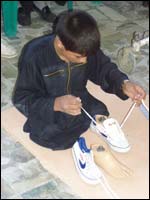
The passengers included four members of a prosthetic team from Hanger Prosthetics & Orthotics. Their mission: Project First Step, with the goal of providing prosthetic care for 40 amputees in ten days during. Did they succeed? Yes-they surpassed their goal by providing prostheses to 55 persons before returning to the US November 1.
Team members were Dale Berry, CP, CP (c), Minneapolis,
Minnesota, team coordinator; Gary Lenzini, CPO, Columbia, Missouri,
lower extremity prosthetics specialist; Richard Mason, New Orleans,
Louisiana, prosthetic materials and fabrication specialist; and
Hugh Panton, CPO, FAAOP, Orlando, Florida, upper-extremity
specialist and transfemoral amputee. The mission was sponsored by
Hanger P&O, with support from Otto Bock Health Care and SFI and
provided more than $100,000 in medical supplies and prosthetic
care.
Afghanis: A Strong, Generous Spirit
What impressions did the team members take home from this
war-torn country? All were impressed by the spirit of the Afghani
people. “They are very warm, generous, genuine people,” said Dale
Berry, team coordinator. “When you go down a street in Kabul,
there’s devastation-bullet holes in the walls, blown-up pieces of
things everywhere. Sanitation is nonexistent, there’s no running
water, no garbage collection, and yet you see people walking down
the street and they’re smiling. The kids are playing.”
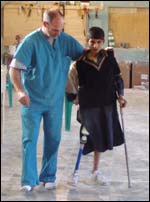
Other team members commented on the perseverance,
pride, and determination of the Afghanis-and a stoic attitude of
making the best of things. Gary Lenzini sensed a feeling of
exuberance: “It’s like a new wave going through. They have freedoms
they didn’t have under the Taliban.” He mentioned a young man in a
restaurant who told him excitedly that a band would be playing
later-under Taliban rule, music was not allowed. Art and drama are
returning; schools and universities are reopening; girls are having
more chance of receiving an education.
“Some of the women patients said their new prostheses would help
them on their jobs,” Lenzini said. “Under the Taliban, they could
not work outside the home. Some women were reduced to begging to
support their families, since they weren’t allowed to have
jobs.”
Without a woman practitioner on the team, being able to provide
prosthetic care for women patients would not have been possible
under the Taliban. Now-although women and children had to be cared
for in a separate room-providing the prosthetic services was no
problem.
Thousands of Amputees
The sheer numbers of amputees in Afghanistan is “mind-boggling,”
noted Hugh Panton. “Probably all the prosthetists in the US could
stay for 25 years and not take care of all the amputees.”
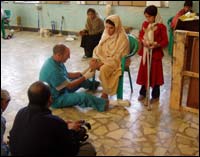
“There are thousands of amputees,” said Berry. “Just going to work, we would see 30-60 amputees. You can go to any street corner, and within two or three minutes you will see an amputee.”
Most of the patients the team treated lost limbs from rocket
attacks and landmine explosions. One woman was in her kitchen when
a rocket came through the house; she lost both an arm and a leg.
One little boy lost his leg when a sniper shot struck him and
killed his mother. His older brother carried him on his back to the
clinic; another boy pushed his brother for three hours in a
wheelchair to get him to the clinic. Many children came without
their fathers and mothers.
“You don’t see the same type of trauma you do in the US-no one
had suffered amputation because of a motorcycle accident or an
accident on a construction site,” said Panton, noting that the limb
losses were all war-related.
One positive factor is the quality of the amputation surgeries.
“In about 95 percent of the amputations, the surgery was done very
well,” Panton said. “They obviously have some very good
doctors.”
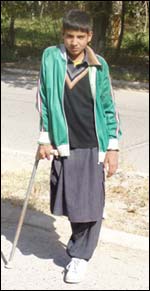
Another plus for the team was being able to focus
on patient care-sans much of the paperwork and administrative
duties required in their home offices. “It was energizing-we could
simply do what we do, which is to see patients and fit prostheses,”
said Lenzini. “We put in some 12-hour days, so we were tired at the
end of the day, but it was a different kind of tired. There was a
feeling of accomplishment.”
The International Committee of the Red Cross (ICRC) also has a
facility in Kabul. “They are doing a very good job,” Panton said.
“The prostheses are basic, but quite functional and well-done.”
However, the sheer magnitude of the country’s need for prosthetic
services is overwhelming, he added.
Meeting Unexpected Challenges
One of the key needs was flexibility-being able to think outside
the box and meet unexpected circumstances and challenges.
Electricity was a big problem. “Sometimes it would work all
day,” commented Richard Mason. “Other days it would be turned off
at 4 or 5 P.M. Sometimes it would go off during the day; it might
be off for five minutes or for two or three hours.”
The team had originally planned to work later in the evening,
but decided in view of the electricity outages, to start work
earlier in the morning.
“We would have to change gears sometimes and work with hand
tools or do other work that didn’t require electricity until it
came back on,” said Lenzini.
Although the Afghanis were very patient, the team didn’t want to
keep people waiting any longer than necessary, so they would keep
several fittings in progress at the same time.
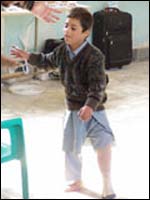
“Most of the first-time prosthesis wearers were
young, mainly teenagers,” said Lenzini. “It was amazing how fast
they would adapt to their prostheses without the benefits of
physical therapy or gait training. It was fantastic to see them
just put down their canes and start walking on their
prostheses.”
Thinking outside the box helped the team come up with solutions.
For instance, one little boy was too small for the prosthetic feet
available, so they made him a peg leg out of a piece of wood. He
used a chair to balance himself as he started to walk. “He was
walking around pushing the chair and yelling, ‘I’m walking! I’m
walking! Take my picture!” Berry recalled.
Triage: A Necessity
With the huge number of patients, triage was a heartbreaking
necessity. For instance, one morning about 40 amputees showed up
since they heard about the clinic. Of these, the team had to sort
through and pick eight to twelve to help and turn the others away.
During the ten days, many had to be turned away. For instance,
there were bilateral transfemoral amputees in wheelchairs that
simply would have required too much time relative to the massive
number of other people needing care. “It would take one whole day
for just that one patient,” noted Panton. The team didn’t have the
needed tools or componentry for some of the other patients.
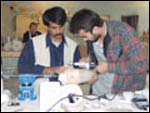
A large number of people needing orthotic care
also came, and since the team wasn’t prepared for orthotic
services, they too had to be turned away.
A couple of young men who were guarding the laboratory were very
interested in the work and eager to help. They were quick learners,
and within a day or two, they were able to do some basic technician
hand work, but Panton would like to see at least two highly
experienced technicians accompany the team if they return. “That
would give us more flexibility and we could provide more services,”
he said.
All the team members commented on how well they worked together
and how much they bonded. Despite the seriousness and urgency of
the mission, they also had fun together and shared some humorous
moments.

Just getting to work was an adventure. As in many
war-torn or developing countries, traffic signals and rules are
few. To get around clogged traffic, drivers often simply go up the
wrong way on a one-way street or up on the sidewalks. Horns blare
as drivers signal, “I’m coming through.” The team members
laughingly agreed that getting to work was going to seem pretty
humdrum and boring back in the States.
Livestock is a frequent sight. One day as they went to work, the
team saw a herd of goats and one team member said, “Those goats are
a long way from home.”
Another member said, “No, they’re not. Those are city
goats.”
“What do you mean, ‘city goats?'”
“They look both ways when they cross the street.”
Would They Go Back?
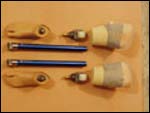
All of the team members commented that the trip
gave them a renewed and enhanced appreciation of the freedom,
material prosperity, and relative safety of life in the US.
However, if they have a chance to go back, would the team
return? The unanimous answer was “in a heartbeat.”
Said Berry, “I can’t stop the Taliban or Al-Quaeda or bring
about world peace. But what I can do is go over there and be part
of a team to help 55 people have a better life. That’s my piece of
the puzzle, and it’s okay by me.”
Photos courtesy of Hanger Prosthetics &
Orthotics.



